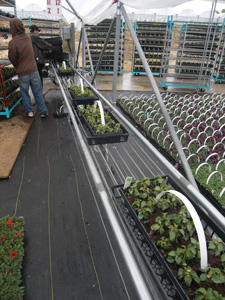5/15/2010
Tunnel Vision
Chris Beytes

While there’s nothing more satisfying than turning the key of a new “Cadillac” greenhouse—you know, that open-roof/Dutch-trays/20-feet-to-the-gutter/all-the-bells-and-whistles glass palace that costs $25 a square foot—sometimes a Chevy is all you really need.
Which was the case for Long Island’s Ivy Acres. This second-generation business has plenty of high-end growing space in three locations in New York and New Jersey. But for a six- to eight-week period each spring, they max that out and need more production capacity. That’s what set them to shopping for a 6-acre structure to put up on a parcel of land next door to their main location in Baiting Hollow, New York.
What they settled on was about as simple a structure as you can erect and still hold your head up when other growers stop by to check it out: the Haygrove PolyTunnel.
Strawberry fields
Haygrove is a 20-year-old UK company that got its start in strawberry production and then branched into the technology of expanding the growing season for domestic berry production through the use of low-cost, portable crop covers—the PolyTunnel. It’s designed to extend the growing season of field crops by providing a protected growing environment at a cost low enough to be justified over many acres of field production. Ivy Acres owners Jack Van de Wetering and his son, Kurt, first saw them being used in England over strawberries and thought they might be just right over their bedding plants.
But why not build a traditional greenhouse—if only low-cost, poly hoop houses?
“It was the parameters that we needed to work within,” answers Kurt. During the winter, he has “all the space in the world,” he says. “It’s only during March into June that I have limited growing space. You couple that with the budget that we’d set and our location—this was already leveled and ready to go—that was a large portion of why we decided to do this.”
Plus, Ivy Acres is known for outdoor growing. They helped pioneer rollout areas and still make extensive use of them, pushing annuals outdoors on Dutch trays as soon as the weather permits. The Haygrove tunnels offer a little more protection, while giving much of the hardening effect they desire.
Haygrove tunnels are simple structures: steel bows, bent on site to the customer’s specs. There are no concrete footings; the bows’ legs are driven deep into the ground. Covering is single poly that’s kept from flapping with crisscrossed ropes. There are no gutters; water just runs into the space where the hoops meet (good thing they have sandy, well-drained soil). Each of the 22 bays is 25 ft. wide, 600 ft. long and 12 ft. high. The only concrete aisle is across the front, for carts.
The plot of land they built on isn’t a nice, neat rectangle, it’s a parallelogram, which means that if they put a rectangular greenhouse on it, they’d waste space—13%, Kurt calculated. The Haygrove design allowed them to easily create a wedge shape along the front and back of the range to fully cover the available ground. “I truly maximized my property,” Kurt says.
Already adding accessories
Strawberry growers leave it at that, but Ivy Acres has added some frills to their low-budget space. Heating, for instance. In-floor heat was piped over from their existing boiler room, giving them four zones of warm soil to grow on—up to 80F, they say.
For ease of filling those 600-ft.-long aisle-less bays, they installed ECHO-Veyor cable conveyors down every other bay (skipping half the bays was another budget item). The ECHO-Veyors will carry anything in a shuttle tray, plus large pots.
Another frill is baskets. They’re testing out the structural strength of the tunnels by installing a trial of 1,800 hanging baskets in one bay. They’re using an interesting technique: PEX cross-linked polyethylene pipe hanging from chains that are fastened to the bows. Drip lines come from the PEX to each pot, and the baskets hang right from the PEX. The PEX hangs from chains rather than directly from the bows to avoid disrupting the ropes that hold the covering. The Haygrove folks approved the design and say it will hold. Cost for the system is $1.25 per hanging basket. “After one turn of baskets you pay for it,” says Vice President Peter Allen.
As for cost, the entire project was $3.50 per sq. ft. complete, including labor, ECHO-Veyors and heat.
Could it replace their rollout?
As mentioned before, Ivy Acres likes to grow crops outside, letting plants toughen up and acclimatize before shipping. “Owning the product all the way through the Home Depot [selling channel], I want a plant that, when it comes out of the greenhouse, it’s still going to live and perform in a store,” Kurt says. The Haygrove tunnels should help them do that … and he says that with the ground heat, they may be able to finish some crops even faster.
Because of that, might they consider Haygrove tunnels over their rollout areas?
“I’m sure we’ll have talks about that in the future,” admits Peter. “It’s been discussed.”
GT